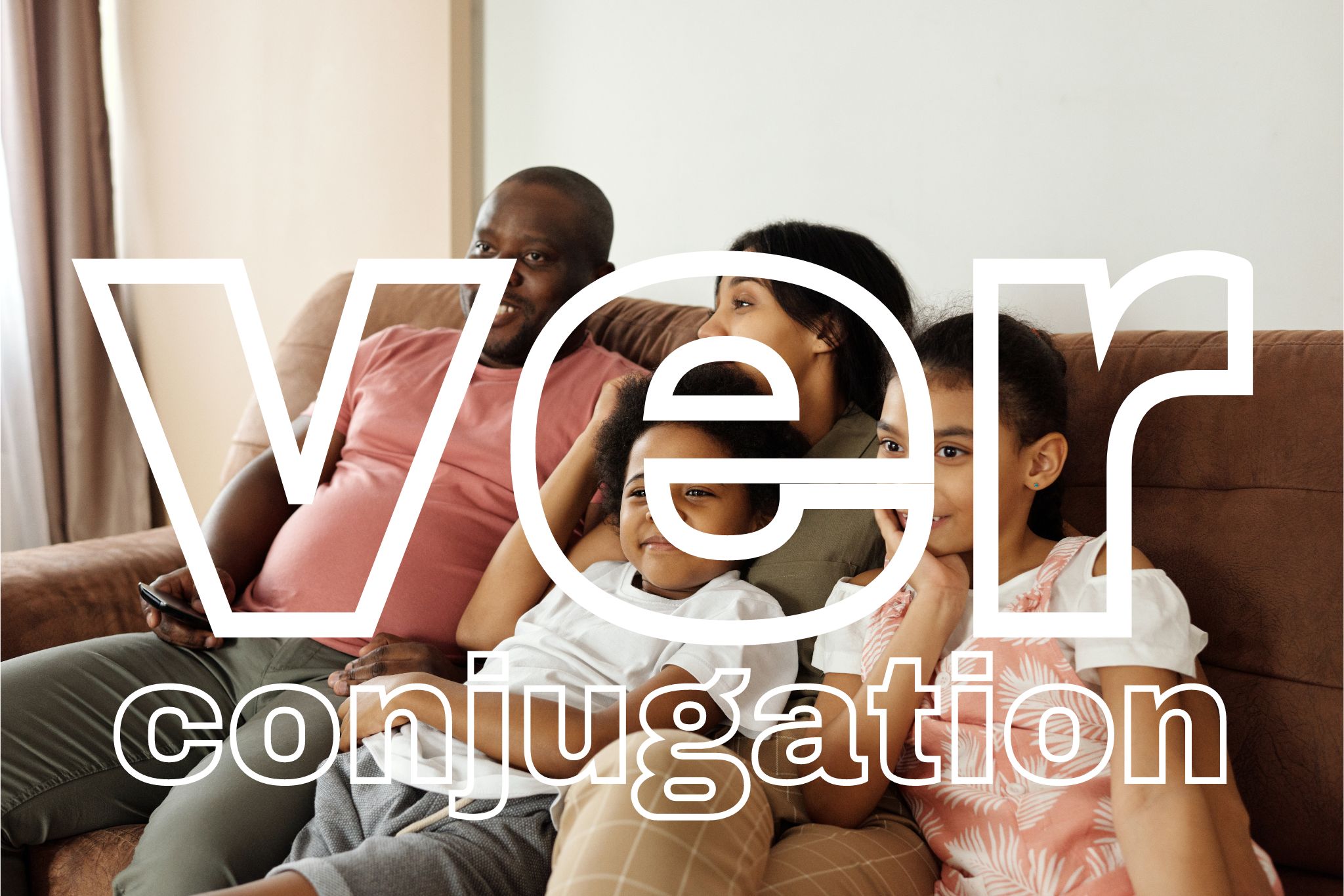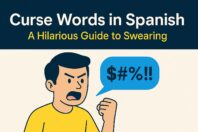Ver conjugation: Every conjugation of Ver in a complete guide

Get our free email course, Shortcut to Conversational.
Have conversations faster, understand people when they speak fast, and other tested tips to learn faster.
More infoIn the vast landscape of the Spanish language, ver stands as a versatile and indispensable verb that Spanish learners will definitely come across often. That’s why it’s very important to really know and understand every ver conjugation.
So today we bring you a complete guide, with a ver conjugation chart for each tense, categorized by verb mood. We’ll begin by taking a look at the main uses of ver, and then jump into our ver conjugations with tons of examples to demonstrate each one.
At the end, you’ll find some exercises to put into practice everything you’ve learned.
¡Veamos las conjugaciones de ver! – Let’s look at the conjugations of ver!
Ver meanings
Before we get into our sections on ver conjugation, let’s begin with a quick rundown of the main ver meanings and uses.
Ver meaning: to see
The most basic translation of ver is to see, referring to the act of perceiving something with the eyes.
- Veo un gatito en tu tejado. – I see a kitten on your roof.
- Rodrigo me está diciendo que no ve tu nombre en la lista. – Rodrigo is telling me that he doesn’t see your name on the list.
Ver meaning: to watch
Ver can also be used as to watch when talking about movies, shows, and events.
- Vamos a ver una película esta noche. – Let’s watch a movie tonight.
- ¿Vamos a ver el partido de los Yankees este sábado? – Are we going to watch the Yankees game this Saturday?
Ver meaning: to check
In some contexts, ver is used to indicate checking something or looking at something carefully.
- Vamos a ver el informe antes de enviarlo. – Let’s check the report before sending it.
- ¿Estás segura de que viste el sobre y que estaba vacío? – Are you sure you checked the envelope and that it was empty?
Verse: to meet up
When used in the reflexive form, verse takes slightly different meanings. The first is for meeting up with someone.
- Nos vemos en el café a las cinco. – We’ll meet at the café at five o’clock.
- Ayer no nos vimos porque me dijo que estaba ocupado. – Yesterday we didn’t meet up because he told me he was busy.
Verse: to appear
Verse can also be used to describe how something looks or appears.
- El cielo se ve muy bonito esta noche. – The sky looks really nice tonight.
- ¿Te sientes mal? Te ves pálida. – Do you feel ill? You look pale.
Ver meaning: to date, to see [someone] romantically
Finally, in some regions, ver indicates dating someone or being in a relationship with someone.
- Llevamos dos meses viéndonos. – We’ve been dating for two months.
- No tuvimos nada serio, solo nos vimos por un par de semanas. – We had nothing serious, we only dated for a couple of weeks.
Ver conjugation
Ver is an irregular verb, meaning that it doesn’t follow regular conjugation patterns of ‑er verbs and that the stem changes in various tenses. Check out our beginner post on ‑er verbs for some of the others similar to ver. Our post on Spanish infinitives also gives a good explanation on how to get the stem for various conjugations. If you’re interested in comparing these irregular verbs between the two languages, we can even recommend this post on French voir conjugation!
Now it’s time to introduce every Spanish ver conjugation in each tense. We’ll break things down by mood and provide plenty of examples, so this whole lesson on ver conjugation can be as smooth as possible. We’ll also provide additional links to our in-depth posts covering each mood and tense. For a broader overview of Spanish conjugation, take a look at our post on all the verb tenses in Spanish!
Now let’s get started with our ver conjugations!
Indicative mood
The indicative mood is used to express statements, facts, or opinions. We’ll take a look at the ver conjugation chart for each tense of the indicative: preterite, imperfect, conditional, future, and all the perfect forms.
Ver present conjugation
The ver conjugation in the present tense follows the conjugation pattern of regular ‑er verbs, meaning that the stem remains ve‑ and is followed by the regular present tense endings.
| Subject | Ver conjugation present tense |
| Yo | veo |
| Tú | ves |
| Él, Ella, Usted | ve |
| Nosotros, Nosotras | vemos |
| Vosotros, Vosotras | veis |
| Ellos, Ellas, Ustedes | ven |
- ¿Qué servicio de streaming usas para ver esa serie? – Which streaming service do you use to watch that TV series?
- ¿Por qué salen tan tarde? ¿No ven el tráfico que hay? – Why are you out so late? Can’t you see the traffic?
- Ya me escuchaste, te veo el sábado aunque estés ocupado. – You heard me, I’ll meet you Saturday even if you’re busy.
Take a look at our post on the simple present tense to master this fundamental tense.
Ver conjugation preterite
The ver preterite conjugation drops the ‑e from the stem, so the preterite stem is simply v‑. We then just add the regular preterite endings. The only exceptions to the regular endings are that there are no accents in the first- and third-person singular yo vi and él/ella/usted vio.
| Subject | Ver conjugation preterite |
| Yo | vi |
| Tú | viste |
| Él, Ella, Usted | vio |
| Nosotros, Nosotras | vimos |
| Vosotros, Vosotras | visteis |
| Ellos, Ellas, Ustedes | vieron |
- Los niños dicen que no vieron a nadie entrar por ahí. – The children say they didn’t see anyone come in that way.
- ¿Alguno vio si cerré la puerta del garaje cuando salí? – Did any of you see if I closed the garage door when I went out?
- Hoy vimos muchos pájaros en el parque. – We saw a lot of birds in the park today.
Refer to our post on how to master the Spanish preterite in minutes for a detailed explanation of this tense.
Ver imperfect conjugation
The ver conjugation in the imperfect tense follows the regular conjugation pattern, with the stem being ve-.
| Subject | Ver imperfect tense |
| Yo | veía |
| Tú | veías |
| Él, Ella, Usted | veía |
| Nosotros, Nosotras | veíamos |
| Vosotros, Vosotras | veíais |
| Ellos, Ellas, Ustedes | veían |
- Mis padres veían muchas películas en el autocine cuando eran adolescentes. – My parents watched a lot of movies at the drive-in when they were teenagers.
- Estaba lloviendo mucho y no veíamos bien el camino. – It was raining a lot and we couldn’t see the road very well.
- Mi hijo no veía bien hasta que se hizo la cirugía láser. – My son couldn’t see well until he had laser surgery.
Spanish has two past tenses, which can be tricky sometimes since the English translations don’t always line up. We recommend our beginner’s guide to the Spanish imperfect tense and our post on preterite vs imperfect if you want to go deeper on these two past tenses.
Ver conditional conjugation
The conjugation of ver in the conditional tense is regular: the stem is ver‑ and the endings remain the same as other -er verbs in the conditional.
The translation of ver in the conditional tense in English is would see or would watch.
| Subject | Ver conditional conjugation |
| Yo | vería |
| Tú | verías |
| Él, Ella, Usted | vería |
| Nosotros, Nosotras | veríamos |
| Vosotros, Vosotras | veríais |
| Ellos, Ellas, Ustedes | verían |
- Si mi abuelo supiera que Susana tiene un tatuaje, no la vería igual. – If my grandfather knew that Susana had a tattoo, he wouldn’t look at her the same way.
- Luisa me dijo que vería las estrellas desde el observatorio esta noche. – Luisa told me she would see the stars from the observatory tonight.
- Si fuésemos al cine, ¿qué película veríamos? – If we went to the movies, what movie would we see?
To learn more about this tense, we recommend our beginner’s guide to the Spanish conditional.
Ver future tense
Ver conjugation in the simple future tense is quite easy, as it’s formed by adding the endings to the infinitive.
The translation of ver conjugated in the future tense is will see.
| Subject | Ver future conjugation |
| Yo | veré |
| Tú | verás |
| Él, Ella, Usted | verá |
| Nosotros, Nosotras | veremos |
| Vosotros, Vosotras | vereis |
| Ellos, Ellas, Ustedes | verán |
- Ellos verán el paisaje desde la ventana cuando lleguen a la posada. – They will see the scenery from the window when they arrive at the inn.
- Si no compro unos anteojos nuevos pronto, no veré nada. – If I don’t buy new glasses soon, I won’t see anything.
- Creo que veremos a mi hermano en Italia el próximo mes. – I think we‘ll see my brother in Italy next month.
Ver compound tenses
Now we’ll be introducing our ver conjugation chart for the indicative compound tenses. To form these tenses in Spanish, we use the auxiliary verb haber conjugated according to the subject, and the past participle.
The past participle of ver is visto.
For progressive tenses we use the gerund, which is viendo.
First, let’s take a look at the present perfect and past perfect conjugations of ver.
| Subject | Present perfect | Past perfect |
| Yo | he visto | había visto |
| Tú | has visto | habías visto |
| Él, Ella, Usted | ha visto | había visto |
| Nosotros, Nosotras | hemos visto | habíamos visto |
| Vosotros, Vosotras | habéis visto | habíais visto |
| Ustedes, Ellos, Ellas | han visto | habían visto |
- Ya le dije que no he visto a ningún hombre con sombrero pasar por aquí. – I already told you that I haven’t seen any man with a hat pass this way.
- Andrea y Carmen lloraban, diciendo que habían visto un fantasma. – Andrea and Carmen cried, saying that they had seen a ghost.
Now let’s see our ver conjugation in the perfect future and perfect conditional tenses.
| Subject | Perfect future | Perfect conditional |
| Yo | habré visto | habría visto |
| Tú | habrás visto | habrías visto |
| Él, Ella, Usted | habrá visto | habría visto |
| Nosotros, Nosotras | habremos visto | habríamos visto |
| Vosotros, Vosotras | habréis visto | habríais visto |
| Ustedes, Ellos, Ellas | habrán visto | habrían visto |
- Para cuando tengas ganas de ir al cine conmigo, ya habré visto mil películas sola. – By the time you feel like going to the movies with me, I will have seen a thousand movies by myself.
- De haberte acompañado, no habríamos visto esta hermosa lluvia de estrellas. – If I had accompanied you, we would not have seen this beautiful meteor shower.
For a detailed breakdown of each of these tenses, head over to our posts on present perfect Spanish, past perfect Spanish, future perfect Spanish, and the Spanish conditional.
Subjunctive mood
The subjunctive mood is used to express subjective or uncertain actions, thoughts, wishes, emotions, doubts, and possibilities. Unlike the indicative mood, which deals with objective facts and reality, the subjunctive introduces an element of subjectivity.
You will notice in the example sentences that the translations are not always the same. This happens because the subjunctive mood in English is used differently and is interpreted using other verb forms. Since we know that this mood can be a bit confusing sometimes, we’ll refer you to our post on the Spanish subjunctive, simplified, for a complete guide.
Let’s dive into each ver subjunctive conjugation in this mood.
Ver present subjunctive
The present subjunctive ver conjugation is easy, as all you have to do is add the verb endings for regular ‑er verbs to the stem of v‑. If you don’t know your present subjunctive endings yet, then our post on the present subjunctive tense in Spanish is the perfect choice.
| Subject | Ver conjugation present subjunctive |
| Yo | vea |
| Tú | veas |
| Él, Ella, Usted | vea |
| Nosotros, Nosotras | veamos |
| Vosotros, Vosotras | veáis |
| Ellos, Ellas, Ustedes | vean |
- Las niñas quieren que las veamos bailar en su presentación de ballet. – The girls want us to watch them dance in their ballet performance.
- Ojalá los jefes vean el gran trabajo que hicimos. – I hope the bosses see what a great job we did.
- No creo que veas bien con los anteojos tan sucios. – I don’t think you can see well with such dirty glasses.
Ver imperfect subjunctive
Ver conjugation in the imperfect subjunctive starts with the stem of v‑, followed by the standard endings of this tense. Remember that there are two possible forms in the imperfect subjunctive, so we provide both options here.
| Subject | Ver conjugation imperfect subjunctive |
| Yo | viera / viese |
| Tú | vieras / vieses |
| Él, Ella, Usted | viera / viese |
| Nosotros, Nosotras | viéramos / viésemos |
| Vosotros, Vosotras | vierais / vieseis |
| Ellos, Ellas, Ustedes | vieran / viesen |
- La profesora nos dijo que viéramos programas de cocina para mejorar nuestras habilidades. – The teacher told us to watch cooking shows to improve our skills.
- Tuve que salir corriendo antes de que me viesen. – I had to run away before they saw me.
- Solo quería que mi hermano viera lo mucho que me esforcé para conseguir su regalo de cumpleaños. – I just wanted my brother to see how hard I worked to get his birthday present.
For an in-depth exploration, don’t miss our post on the Spanish imperfect subjunctive tense.
Ver future subjunctive
Keep in mind that in modern Spanish, the future subjunctive has become obsolete, and it is no longer used in everyday speech or writing. However, it can still be found in literary contexts, so we include our ver conjugation chart for this tense in case you come across it at some point.
| Subject | Ver future subjunctive |
| Yo | viere |
| Tú | vieres |
| Él, Ella, Usted | viere |
| Nosotros, Nosotras | viéremos |
| Vosotros, Vosotras | viereis |
| Ellos, Ellas, Ustedes | vieren |
- Quien viere a este malhechor y no lo denunciare, servirá la misma sentencia. – Whoever sees this evildoer and does not denounce him, will serve the same sentence.
- Aunque no viéremos salida, tu poder nos guiará hacia la victoria. – Though we see no way out, your power will guide us to victory.
Compound ver subjunctive conjugation
Just like the indicative, the compound tenses in the subjunctive mood are conjugated with the auxiliary verb haber along with the ver past participle: visto.
The compound subjunctive tenses are the perfect subjunctive and the pluperfect subjunctive. Since the pluperfect subjunctive relies on the auxiliary verb being conjugated in the imperfect subjunctive, which has two correct conjugation forms, the pluperfect subjunctive has two correct forms too.
| Subject | Perfect subjunctive | Pluperfect subjunctive |
| Yo | haya visto | hubiera visto / hubiese visto |
| Tú | hayas visto | hubieras visto / hubieses visto |
| Él, Ella, Usted | haya visto | hubiera visto / hubiese visto |
| Nosotros, Nosotras | hayamos visto | hubiéramos visto / hubiésemos visto |
| Vosotros, Vosotras | hayáis visto | hubierais visto / hubieseis visto |
| Ellos, Ellas, Ustedes | hayan visto | hubieran visto / hubiesen visto |
- Siento mucho que hayas visto esta escena tan vergonzosa, Juan. – I’m sorry you saw such a shameful scene, Juan.
- Si hubiésemos visto algo sospechoso, le habríamos avisado de inmediato, Sr. Pérez. – If we had seen anything suspicious, we would have told you immediately, Mr. Perez.
Imperative mood
The Spanish imperative is a verb form used to give commands, make requests, or offer suggestions in a direct and concise manner. Note that the ver conjugation in the imperative varies depending on if the sentence is affirmative or negative, so we include both conjugations here.
| Subject | Ver imperative |
| [Tú] | ve / no veas |
| [Usted] | vea / no vea |
| [Nosotros, Nosotras] | veamos / no veamos |
| [Vosotros, Vosotras] | ved / no veáis |
| [Ustedes] | vean / no vean |
- No vean esos programas tan violentos, chicos. – Don’t watch such violent programs, kids.
- Veamos qué postres hay en el menú. – Let’s see what desserts are on the menu.
- ¡Vean por dónde van! ¡Casi me hacen derramar el café! – Watch where you’re going! You almost made me spill my coffee!
Take a look at our post on Spanish commands to learn everything about this mood.
Conclusion
Well done! Now it’s time for a quick recap to make sure everything is clear.
In this comprehensive guide, we have explored the multifaceted verb ver in Spanish, a versatile and indispensable element of the language that every Spanish learner will undoubtedly encounter frequently.
Starting with an overview of ver meanings and uses, we delved into its various translations including to see, to watch, to check, and to date. We also explored how the reflexive form verse introduces new meanings, such as to meet or to appear.
Then we covered ver conjugation, learning that it’s an irregular verb with stem changes in some tenses, and providing a detailed ver conjugation chart for each tense. We covered every tense, organized by mood, with plenty of examples to demonstrate each ver conjugation in action.
Thanks for reading! ¡Nos vemos pronto! – See you soon!
Ver conjugation exercises
Are you prepared to challenge your conjugation abilities? How about giving this set of exercises a go to assess your mastery of ver conjugation?
Give it your all, and let’s find out how proficient you are in handling these conjugations based on the mood and tense indicated in parentheses. The answers and translations are available below.
1. Mi hermana _____ hoy a su mejor amiga después de mucho tiempo. (indicative: future)
2. No _____ a las personas fijamente, Ana, es de mala educación. (imperative)
3. ¿Quién _____ si el trabajo quedó bien hecho? Necesito un supervisor. (indicative: conditional)
4. No creo que no _____ el letrero, si es gigante. (subjunctive: present)
5. Si _____ tus diseños primero, habría comprado tus vestidos y no aquellos. (subjunctive: pluperfect)
6. ¿Te gusta ese programa? Tu tío y yo siempre lo _____ cuando éramos niños. (indicative: imperfect)
7. Las muchachas no _____ a Javier llegar. (indicative: preterite)
8. Ya _____ esto pasar muchas veces y sé lo que hay que hacer. (indicative: present perfect)
9. Muévete, por favor. No _____ nada si te quedas ahí parado. (indicative: present)
10. Si la profesora _____ lo mucho que me tardé haciendo esta tarea, estaría orgullosa de mí. (subjunctive: imperfect)
Answers
1. Mi hermana verá hoy a su mejor amiga después de mucho tiempo. – My sister will see her best friend today after a long time.
2. No veas a las personas fijamente, Ana, es de mala educación. – Don’t stare at people, Ana, it’s bad manners.
3. ¿Quién vería si el trabajo quedó bien hecho? Necesito un supervisor. – Who would check if the job was well done? I need a supervisor.
4. No creo que no vean el letrero, si es gigante. – I don’t think they won’t see the sign, it’s huge.
5. Si hubiera visto / hubiese visto tus diseños primero, habría comprado tus vestidos y no aquellos. – If I had seen your designs first, I would have bought your dresses and not those.
6. ¿Te gusta ese programa? Tu tío y yo siempre lo veíamos cuando éramos niños. – Do you like that show? Your uncle and I always watched it when we were kids.
7. Las muchachas no vieron a Javier llegar. – The girls didn’t see Javier arrive.
8. Ya he visto esto pasar muchas veces y sé lo que hay que hacer. – I’ve seen this happen many times before and I know what to do.
9. Muévete, por favor. No veo nada si te quedas ahí parado. – Move, please. I can’t see anything if you just stand there.
10. Si la profesora viera / viese lo mucho que me tardé haciendo esta tarea, estaría orgullosa de mí. – If the teacher saw how long it took me to do this assignment, she would be proud of me.



